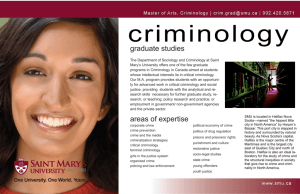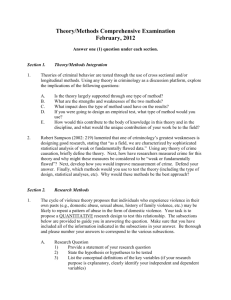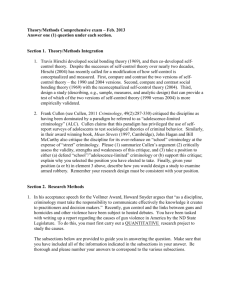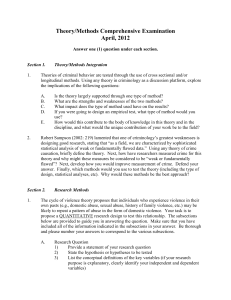criminology goes to the movies
advertisement
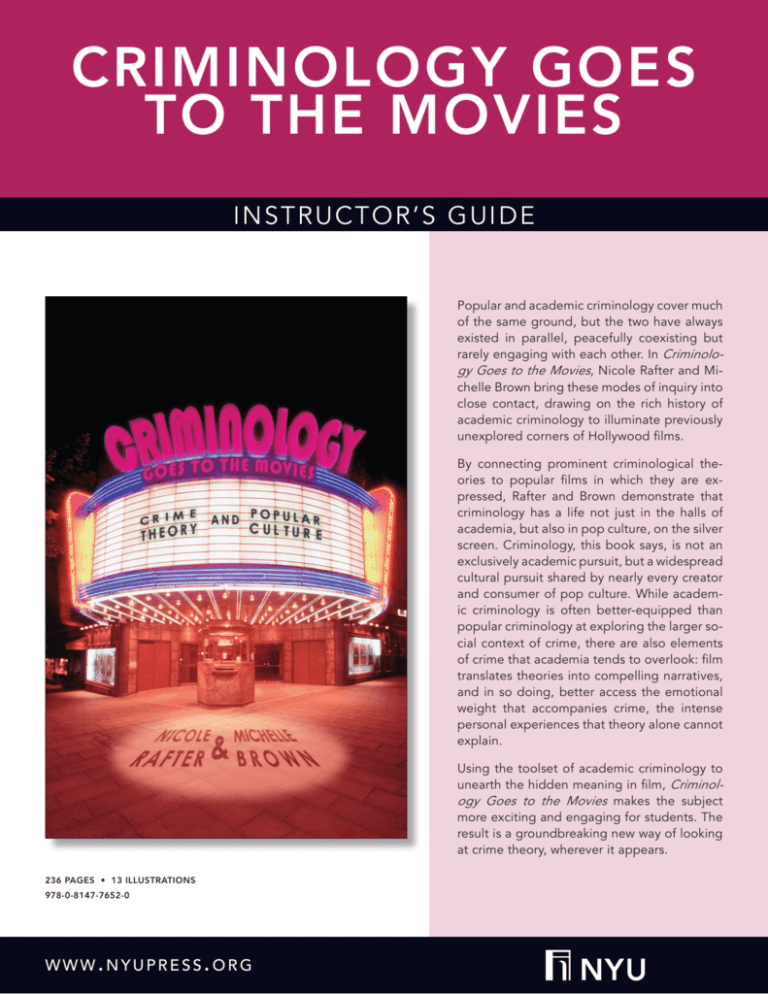
CRIMINOLOGY GOES TO THE MOVIES INSTRUCTOR’S GUIDE Popular and academic criminology cover much of the same ground, but the two have always existed in parallel, peacefully coexisting but rarely engaging with each other. In Criminology Goes to the Movies, Nicole Rafter and Michelle Brown bring these modes of inquiry into close contact, drawing on the rich history of academic criminology to illuminate previously unexplored corners of Hollywood films. By connecting prominent criminological theories to popular films in which they are expressed, Rafter and Brown demonstrate that criminology has a life not just in the halls of academia, but also in pop culture, on the silver screen. Criminology, this book says, is not an exclusively academic pursuit, but a widespread cultural pursuit shared by nearly every creator and consumer of pop culture. While academic criminology is often better-equipped than popular criminology at exploring the larger social context of crime, there are also elements of crime that academia tends to overlook: film translates theories into compelling narratives, and in so doing, better access the emotional weight that accompanies crime, the intense personal experiences that theory alone cannot explain. Using the toolset of academic criminology to unearth the hidden meaning in film, Criminology Goes to the Movies makes the subject more exciting and engaging for students. The result is a groundbreaking new way of looking at crime theory, wherever it appears. 236 PAGES • 13 ILLUSTRATIONS 978-0-8147-7652-0 www.nyupress.org NYU TA KIN G CR IM IN OLOGY T O T HE M O VI ES INTROD UCTI ON 2 pages 1-13 SUMMARY This introductory chapter argues that it is crucial for academic criminology to recognize the role of popular culture in understandings of crime. Siloing the two leaves criminology incomplete. Academic criminology provides the tools to understand crime’s empirical impact on society, but there are aspects to crime that this model cannot address: the individual stories, the emotionality of both transgression and victimhood; these film handles with ease. Furthermore, film has a much greater audience reach than academic criminology. Indeed, it is the medium through which the vast majority of people will be encouraged to think about the causes of crime, and so film has a proportional effect on social conception of crime. Academic criminology’s tendency to discount popular media leaves it blind to a large swath of its own subject matter. After making the case for integrating these two perspectives, this intro presents an overview of the coming chapters, and explains that though they are arranged by theory, in the order that the theories were developed, each chapter can be read independently, in any order. QUESTIONS FOR DISCUSSION ➥➥ Why do the authors claim filmic depictions of crime are so important to criminological theory? ➥➥ This book covers a wide variety of films released across several decades. What are some ways in which crime films have changed over time? ➥➥ What are some common beliefs about criminals that likely originated in film, both positive and negative? ➥➥ Some film genres, like heist films, are made specifically to depict crime. How are the criminals represented in these genres? The crimes they commit? NYU PRESS INSTRUCTOR’S GUIDE This chapter explores rational choice theory in relation to the film Double Indemnity. Cesare Beccaria’s view of crime was that actors make the rational choice to break the law by weighing both benefits and costs; if the personal benefit outweighs the potential cost - punishment, then the actor will commit the crime. Therefore, Beccaria viewed deterrence as a careful science of matching crimes to punishments such that the cost-benefit analysis reliably discourages lawbreaking. This theory emphasizes personal choice in the commission of crime while almost completely discounting environmental factors. The film Double Indemnity shows this exact rational choice process for Walter Neff, an insurance salesman who decides to commit murder for love and money, and suffers dire consequences for his decision. Modern criminology, however, recognizes that the few crimes are purely rational; all are shaped by the environment in which they are committed. Even contemporary film has begun to defy rational choice theory. Collateral, for instance, posits a world so bleakly nihilistic that it strips all life of any meaning, thereby undermining the free will of its actors. QUESTIONS FOR DISCUSSION ➥➥ How does rational choice theory explain criminal behavior? ➥➥ Are there relevant factors that rational choice theory does not address? How do these omissions affect the theory’s validity? ➥➥ How is rational choice theory represented in Double Indemnity? CH AP TER 2 SUMMARY “F O R M O N EY A N D A WOM AN ” pages 14-27 ➥➥ What factors does Walter Neff consider while contemplating murder? Are there influences beyond his free will that led to the crime? CRIMINOLOGY GOES TO THE MOVIES 3 “ HE’ S A LI VE! ” CH AP TER 3 pages 28-46 SUMMARY The chapter introduces several biological theories of crime and the films in which they are explored. One of the first biological theorists was Cesare Lombroso, the 19th-century psychiatrist who authored Criminal Man. Lombroso’s text claimed that most criminals were a holdover from an earlier stage in evolution, biologically different from normal, law-abiding people. Criminals can be identified by their physical characteristics, which mirror their twisted and feeble minds. Distressingly, the characteristics Lombroso identified as innately criminal were biased against ethnic minorities, and meshed well with other aspects of the period’s scientific racism. Over time, and particularly after the eugenic horrors of the Holocaust, these biological theories were supplanted by biosocial theories, which acknowledged both internal and external influences on potential criminals. The films representing these theories also change over time: James Whale’s Frankenstein proposes that characters in the film behave violently and cruelly due to their physical attributes and deformed brains, where many decades later, in a film like Monster, killer Eileen Wournos is portrayed as an inevitable product of her environment and upbringing. Finally, Criminology Goes to the Movies suggests that film can be used to alert people to the dangers of biological pigeonholing, and build empathy for people whose life circumstances pushed them toward crime. QUESTIONS FOR DISCUSSION ➥➥ How do racial and ethnic biases manifest in Lombroso’s “Criminal Man” theory? ➥➥ In what cases have biological theories of crime been applied historically? Does that affect their reception in the scientific community today? ➥➥ How do biological and social factors interact in the biosocial model? ➥➥ Which model(s) best explains the deviant behavior of Frankenstein’s monster? What about his assistant, Fritz? 4 NYU PRESS INSTRUCTOR’S GUIDE This chapter introduces three fields of study – behavioral psychology, psychoanalysis and psychiatry – that attempt to explain the human mind and its effect on behavior. Behavioral psychology is a learning theory which states that all human beings begin as “blank slates,” their behaviors formed from interaction with their environments. Psychoanalysis, a field pioneered by Freud, holds that three different elements of personality – the ego, superego, and id – are locked in a never-ending battle that accounts for most of the vagaries of human behavior. Lastly, psychiatry is a branch of medicine which specializes in diagnosis, treatment, and prevention of mental illness. Alfred Hitchcock’s Psycho introduces a criminal, Norman Bates, who kills a young woman according not just to one but possibly several equally valid psychological, Freudian and psychiatric causes, including voyeurism, sadism, a split personality, and Oedipal rage and guilt. The film provides a diagnosis but undercuts it in the same breath, leaving the audience uncertain as to Bates’ true motives. Two other films, M and The Boston Strangler, contemplate whether we should hold the mentally unstable responsible for their crimes at all. Neither provides a concrete answer, but presenting the issue to a wide audience brings it into the debate and prompts viewers to form their own opinions. QUESTIONS FOR DISCUSSION CH AP TER 4 SUMMARY “BLO O D, M O T HER , BLOOD !” pages 47-66 ➥➥ What are the differences between psychology, psychoanalysis and psychiatry? ➥➥ Do you believe behaviorist John Watson’s claim that humans are “blank slates,” or are we born with certain tendencies already? ➥➥ In Psycho, does the psychiatrist simplify Norman’s motives? What are some other explanations for his crimes? ➥➥ What stances do M and The Boston Strangler take on the issue of punishing those who are mentally unstable? What reasons do they provide? CRIMINOLOGY GOES TO THE MOVIES 5 “Y OU TA L K I N G T O M E?” CH AP TER 5 pages 67-82 SUMMARY This chapter explores the effect of transitional neighborhoods on social order, as described in social disorganization theory. According to the Chicago school, the “transitional zone,” regions of large cities characterized by poverty, heterogeneity, transition, and disorder, are susceptible to crime because they lack social cohesion. The typical community is close-knit and proactive, and will move to correct and regulate issues on its own; the transitional community, however, lacks the social capital to perform these functions, so problems go unaddressed and are allowed to fester. “Hood” films like Boyz n the Hood exemplify the transitional environment, with the ubiquity of violence, alcohol and drugs. When a community is unable to enforce social order, individuals will look elsewhere, often to crime, to reclaim a sense of control in their lives. In Taxi Driver, New York’s transitional environment inspires social isolation, powerlessness and disgust on the part of Travis Bickle, the film’s war veteran anti-hero. The mounting corruption and filth Bickle witnesses in his transitional zone erode his mental state, and ultimately he turns to vigilantism and murder to eliminate social ills that the city will not address. QUESTIONS FOR DISCUSSION ➥➥ What are the defining characteristics of a “transitional zone”? ➥➥ How do conditions in the transitional regions of major cities relate to crime and delinquency? ➥➥ What other transitions are happening in American society at large in Taxi Driver, and how does Travis Bickle respond to them in the film? ➥➥ Why are authorities in Taxi Driver so eager to dismiss Travis Bickle’s crimes as heroic acts? Is this adulation likely to address his underlying problems? 6 NYU PRESS INSTRUCTOR’S GUIDE This chapter deals with strain theory, the idea that people resort to crime when they cannot cope with life’s stresses through lawful means. Strain occurs under a condition sociologist Emile Durkheim called anomie, in which, due to social-structural shifts, individuals are no longer acting in accord with accepted social norms. Robert K. Merton further defined strain as a disjunction between goals and means: without legitimate means to reach their goal, people will turn, by necessity, to illegitimate means. Faded for several decades, general strain theory (GST) was revived in the 1990s by Robert Agnew with an eye for individual factors, and later, Steven Messner and Richard Rosenfeld devised institutional anomie theory (IAT), in which strain is created by whatever institution exerts the most social, political or economic pressure. These forces interact and collide in Traffic, where people are driven toward the drug trade and a drug war fueled by social, personal and institutional factors. In a world where the drug trade is the overriding institution, its demands place strain on people at every level, including police officers, legislators, drug users, producers and distributors. QUESTIONS FOR DISCUSSION ➥➥ Which are the most common strains that might lead a person to turn to crime? ➥➥ How does Agnew’s general strain theory differ from the classical theory? From Messner and Rosenfeld’s institutional anomie theory? ➥➥ What is the dominant institution in Traffic, and how does it put strain on the characters in the film? CRIMINOLOGY GOES TO THE MOVIES CH AP TER 6 SUMMARY “YO U ’ RE G I VI N G ME A N E R VOUS BR EAKDO WN” pages 83-100 7 G E T T I N G T HE DRI F T CH AP TER 7 pages 101-118 SUMMARY This chapter describes social learning theorists’ arguments that criminal behavior is a learned behavior like any other. According to Edwin Sutherland’s differential association theory, criminality is learned through close association, typically from those who belong to deviant subcultures. Differing attitudes toward crime among individuals can be explained by their different learning groups. Criticizing Sutherland’s inability to explain where these associations originated, Albert Cohen further defined the learning environment as a delinquent subculture. A delinquent subculture, according to Cohen, forms as a social reaction to status discontent, a repudiation of middle-class values by working-class males. This view of isolated, distinct subcultures is exemplified by Mystic River, which depicts a unique set of social norms in a working-class Boston community. In this Irish Catholic enclave, strength, decisiveness and self-sufficiency are part of the community’s shared values, and these values guide Jimmy Markum’s actions throughout the film, even to the point of taking the law into his own hands and avenging a loved one’s death. Apart from social learning, Sutherland also popularized the life-history approach with the publication of The Professional Thief, and almost single-handedly inserted white-collar crime into the criminological conversation. His original social learning theories may have surrendered their prominence to control theories, but Sutherland’s contribution to criminological study remains towering. QUESTIONS FOR DISCUSSION ➥➥ How have Sutherland’s critics rebutted his social learning theory? ➥➥ Which social norms prompted Jimmy Markum to take action in Mystic River? ➥➥ In what cases, if any, is the “life history” approach superior to quantitative academic studies? How does it falls short? ➥➥ How do capitalist norms and values contribute to “white collar” crime? 8 NYU PRESS INSTRUCTOR’S GUIDE This chapter explains labeling theory and the role of the state in defining crime. The theory’s central premise is that when the state labels an individual as “criminal” or “deviant”, they reorient their lives and behavior around this label. It creates, in effect, a self-fulfilling prophecy, in which those deemed “criminals” by society are unable to escape that mark. This is especially true given that “crime” is a moving target; at points throughout history, the word has targeted minorities, homosexuals, and the mentally and physically disabled. Note that society engages in labeling even in less extreme, non-criminal circumstances; whenever a new group emerges that is seen as a threat to community values, society is keen to label them as “a problem.” As in the Friedman case, the media plays a central role in fueling these witch-hunts, like the panic surrounding the harmless British youth gangs of the 1960s. Labels play an integral part in Capturing the Friedmans, as Arnold and Jesse Friedman are accused of sexually molesting young boys, and thus labeled by the local community, government and media as “sex offenders.” Arnold, a respected community memebr and teacher, sees his positive labels eroded over time by the negative; the degradation of his character becomes so extreme that eventually it permeates his entire household, and the bonds of trust between him and his family break down. The power of labels hugely affect the events of the Friedmans’ trial and sentencing, and Jesse still bears the mark of “deviant” today. QUESTIONS FOR DISCUSSION ➥➥ What are some examples of moral panics started by labeling in the media? How accurate were their claims, in hindsight? ➥➥ How might the label of “criminal” keep a person from escaping a life of crime? ➥➥ How do the facts and accusations revealed throughout the Friedman case contribute to the labeling of Arnold and Jesse? ➥➥ What effects do the labels placed on Arnold and Jesse have on the community? The family unit? The trial and ultimate sentencing? CRIMINOLOGY GOES TO THE MOVIES CH AP TER 8 SUMMARY “PO RN O G RA PHY IN FOOT-H IGH S TA CKS” pages 119-137 9 F IG HT T HE PO W ER CH AP TER 9 pages 138-152 SUMMARY This chapter examines Spike Lee’s Do the Right Thing in relation to conflict theory. This theory states that individuals’ actions are constrained by the social structures in which they live; in Do the Right Thing the strictures are those of American capitalism, which affects the interactions among people of different stations or classes. Wealth distribution is unequal in capitalist systems, so those disadvantaged by the system are placed into a state of conflict in which they must turn to crime to provide for themselves. In Do the Right Thing, these tensions manifest themselves among different racial and ethnic groups, police and minorities, and business owners and patrons. This tension swells until, near the film’s end, it culminates in a neighborhood uprising and the defacement of a local business. Yet despite the anger and chaos, the underlying issues that plague the community remain unresolved, demonstrating that the only way to heal the wounds caused by conflict is to change society itself, lessening or removing its constraints. Thus, social reform is at the very heart of conflict theory, and theorists often involve themselves in movements related to social inequality. QUESTIONS FOR DISCUSSION ➥➥ On which individuals or institutions does conflict theory place the ultimate responsibility for crime? ➥➥ How do Karl Marx’s theories on wealth, property and labor fit into conflict theory? ➥➥ What tensions demonstrated in Do the Right Thing must be addressed, if Mookie’s nighborhood is to escape the cycle of conflict? ➥➥ What are we to make of Mookie and Sal’s reconciliation at the film’s end? 10 NYU PRESS INSTRUCTOR’S GUIDE This chapter examines criminology in film through the lens of feminism. For feminist criminologists, life is dominated by masculine perspectives, and much of the discourse ignores or minimizes the importance of women. In trying to bring women closer to the center of the discussion, feminist criminologists examine crime in relation to traditional gender roles. The film shows that crime itself derives from our understanding of these roles. Central to feminist criminology is the concept of “doing gender,” a socially constructed performance that informs what behaviors are “right” or “natural.” Gender performances can help us understand why men are more likely to commitcertain crimes (robbery, assault, rape) and women others (street-level prostitution). By examining these gender roles and society’s reactions to them, we can better understand the factors that lead women, specifically, to criminality, as well as the societal effects of crime on female victims. In Thelma & Louise, two women go on what outwardly appears to be a cross-country crime spree, but in reality is spurred by gendered violence and the shortcomings of a law enforcement system that marginalizes women. The film, remarkable at its release for its handling of gender issues, poses difficult questions about patriarchal society and women’s ability to exist within it, and in doing so sparked a passionate critical response that remains contentious to this day. CH AP TER 10 SUMMARY “LET HER G O ” pages 153-166 QUESTIONS FOR DISCUSSION ➥➥ What does “doing gender” mean in the context of feminist criminology? ➥➥ How do gender performances contribute to the “gender gap” between male and female offenses? ➥➥ How is masculinity performed in Thelma & Louise? What might a feminist male presence in the film look like? ➥➥ Why don’t Thelma and Louise turn themselves in after their first “crime”? ➥➥ In the ending of Thelma & Louise, do the pair break free of the patriarchal system, or succumb to the futility of resisting it? CRIMINOLOGY GOES TO THE MOVIES 11 “A MAT T ER O F T I M E” CH AP TER 11 pages 167-183 SUMMARY This chapter examines the importance of one’s life-course in creating repeat offenders. John Laub and Robert Sampson described the lives of potential criminals in terms of trajectories and turning points; a trajectory being a longterm pattern of behavior, and a turning point being a single event that radically shifts one’s trajectory. In this model, the path to criminality is a linear one with significant life events serving as forks in the road. Terrie Moffitt furthered developed the theory by differentiating “adolescence-limited” offenders, who desist from crime after a certain age, from the “life-course persistent” law-breakers who offend throughout their lives. The life-course persistent, Moffitt argued, are created through a combination of neuropsychological vulnerability and environmental influences; subjects who exhibit antisocial tendencies while also growing up in disadvantaged households are more likely to become life-course persistent. Shadd Manura inquired further into what makes some criminals desist from their old behavior and “make good,” as opposed to those who persist. Various life-courses are examined in City of God, which shows a young boy, Rocket, growing up in a Brazilian favela where children regularly become criminals at an early age. While Rocket’s talent for photography serves to bring him to a crucual turning point, other boys living in the City of God, like Li’l Ze, are doomed to a life-course of criminality and violence. QUESTIONS FOR DISCUSSION ➥➥ What factors differentiate adolescence-limited offenders from the life-course persistent? ➥➥ What are common “turning points” that are likely to turn past offenders from a life of crime? ➥➥ How do children in the City of God define maturity and adulthood, if not by age? ➥➥ Where will Rocket’s life-course likely take him? What about Li’l Ze, had he survived into adulthood? 12 NYU PRESS INSTRUCTOR’S GUIDE The concluding pages offer a summary of the book’s main argument. Academic and popular criminology are not as separate as they appear; they are, in fact, deeply symbiotic ways of understanding that each have much to learn from the other. Academic criminology gains a fuller account of the subjective elements of crime that it often overlooks, and crime films gain, in return, a more precise understanding of the theories that they invoke. This melding of the two types of knowledge creates new understandings of crime that will be more engaging for criminology students, while also enriching and strengthening the study of crime. QUESTIONS FOR DISCUSSION CON CLUSION SUMMARY T HE BI G PI C T U RE pages 186-189 ➥➥ The authors assume that grounding criminological theory in popular culture makes it more accessible to students. Did you find this to be the case? ➥➥ How did you view crime films before reading this book? Did you assume a high level of accuracy, or did you allow for broad creative license? ➥➥ What did you know about criminology before reading this book? How has this book supplemented your knowledge? ➥➥ Has learning more about criminology changed your expectations for how crime is represented in film? ➥➥ The authors discuss crime films as a worthy branch of academic study. Do crime films have additional positive functions outside of academia? CRIMINOLOGY GOES TO THE MOVIES 13

